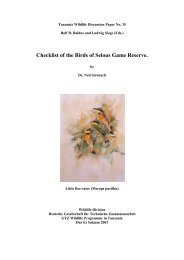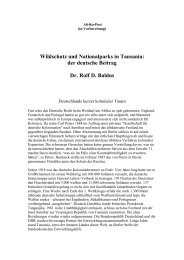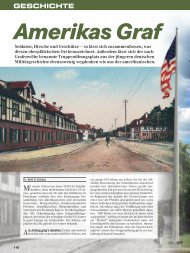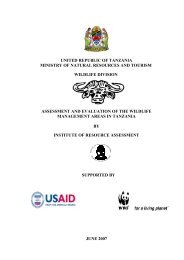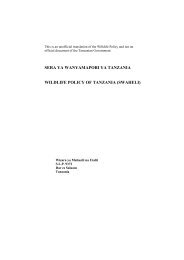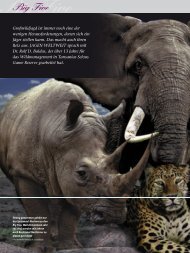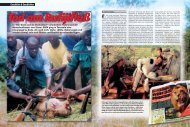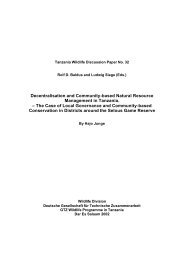African Indaba Articles - wildlife-baldus.com
African Indaba Articles - wildlife-baldus.com
African Indaba Articles - wildlife-baldus.com
Create successful ePaper yourself
Turn your PDF publications into a flip-book with our unique Google optimized e-Paper software.
certain low volume species which have been auctioned in 2005 but not in 2004. For instance, elephant (21sold at R24,762 average), leopard (3 sold at R32,667 average), lion (39 sold R21,833 average), scimitarhornedoryx (4 sold at R17,000 each), golden cat (2 sold at R10,000 each) and some exotics like Bengaltiger (5 sold at R34,400 average) and water buffalo (4 sold at R21,00 average).The auction prices for most game animals have dropped, some rather significantly, in 2005. For instance,the average price of R111,155 for disease-free buffalo did not even reach the 2002 level; the price for “black”impala dropped to about a quarter of the prices realized since 2001; red lechwe reached a low of R4,750 –less than half of the 2002 price and a third of the 2004 price; the single black rhino sold in 2005 fetchedR100,000 – a far cry from the half million Rand mark reached in both 2001 and 2002; its white cousinexperienced a continuous drop from the record prices of 2001/2002 to fetch just under R100,000 average for137 animals; both Roan and Sable experienced also significant drops. Astonishingly, springbuck, kudu, elandand impala had some revival, with prices mostly up.In terms of numbers, impala leads the pack with 3,886 sold, in front of blue wildebeest (1,552) andblesbuck (1,502); other animals traded in significant numbers are: kudu (1,240), <strong>com</strong>mon springbuck (839),eland (777), gemsbuck (768), nyala (690), waterbuck (688), Burchell’s zebra (684).<strong>African</strong> <strong>Indaba</strong> will publish the final statistics for 2005 in pdf-format on the 2006 Archive Page within thenext 2 months. There you will also find the US-Dollar equivalents based on average yearly exchange rates.Conclusions:The signs are on the wall for some time already, and I expect no recovery in prices for the current year.Most land, which could or can be converted back from agricultural to <strong>wildlife</strong> habitat, has experienced thistransformation already. The owners of land in transformation have been the buyers of <strong>wildlife</strong> in the past; andthey will be<strong>com</strong>e producers of <strong>wildlife</strong> once their game stocks are surpassing the carrying capacity of thefenced land.The provincial and national protected areas in South Africa have long since been suppliers of <strong>wildlife</strong> forgame auctions, since this is their only significant way to realize revenue from surplus game (the exceptionare a few “enlightened” provincial authorities, who also permit trophy and/or biltong hunting within theirprotected areas).I envisage that the trade in life game will – especially with a tighter new legislation in the pipeline regardinggame breeding, trade and also regarding land ownership resp. tax incentives, – experience further declinesin 2006. We might well see a trend towards a situation, where, in order to maintain genetic diversification,game is rather exchanged than traded.The game on private and public land will not stop to reproduce and game populations will quickly reachmaximum carrying capacity level. Landowners, both public and private, are to manage their <strong>wildlife</strong> areas interms of the National Biodiversity Act; social responsibility requires, however, not conservation-centrism, buta holistic triple-bottom-line approach with tangible ecological, economic and social benefits in line with theSouth <strong>African</strong> Government’s stated policy.Hunting can play an important role in the development. The Department of Tourism & EnvironmentalAffairs would be well advised to draw on international expertise as offered by the International Council forGame and Wildlife Conservation – CIC. A close cooperation with <strong>wildlife</strong> producers (Wildlife Ranching SouthAfrica, SA National Parks, Provincial Parks), local and tourist hunters (i. e. Confederation of South <strong>African</strong>Hunting Associations – CHASA, Professional Hunters’ Association of SA – PHASA and international hunters’associations) is also essential.I, therefore, state my point again – as I did already in the article “Hunting in South Africa: Facts, Risks,Opportunities”, published in <strong>African</strong> <strong>Indaba</strong> Vol 3, No 4 and 5, and in subsequent editorials as well as in theeditorial remarks on page 1 of this issue of <strong>African</strong> <strong>Indaba</strong>:We will have to find workable ways to achieve triple bottom line results in the protected areas in SouthAfrica. As a foremost objective, the solutions must be inclusive of the vast, but silent majority of South<strong>African</strong>s. We cannot afford to be dictated by utopian animal rights views of a small but vociferous urbanminority and some media which make it their business to have un- and underinformed writers to misrepresentfacts.88



